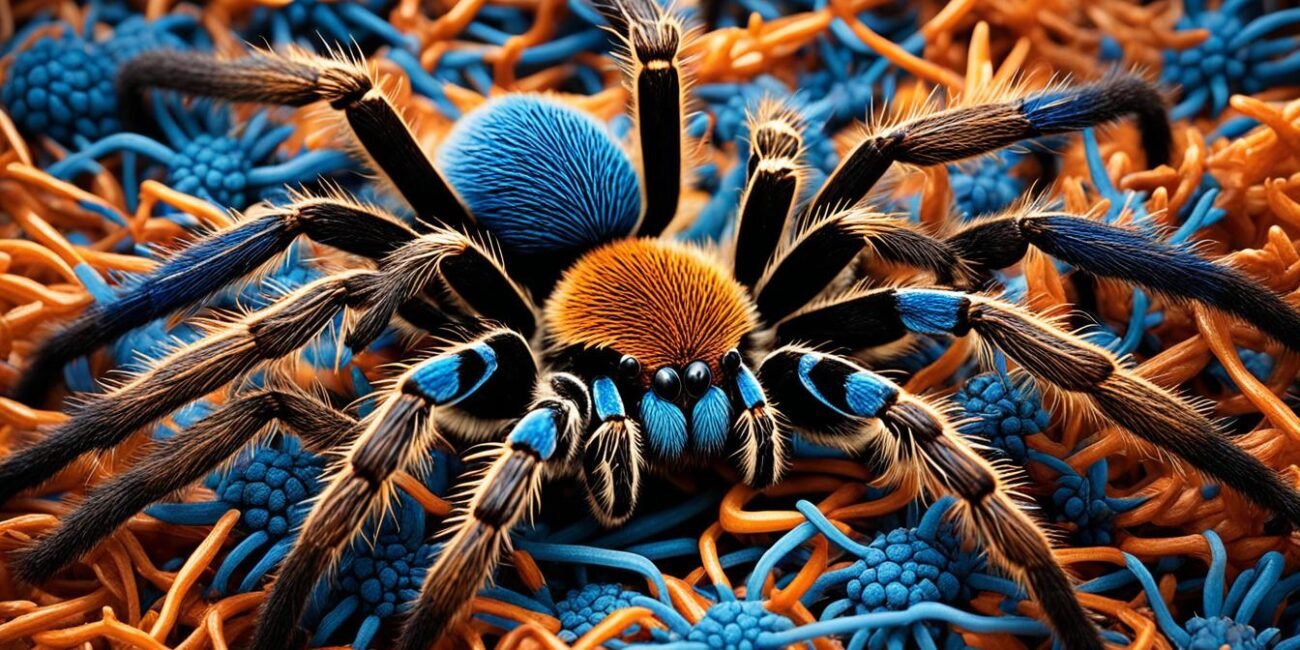Welcome to our guide on tarantula species! Tarantulas, also known as theraphosids, are fascinating creatures with a wide variety of species. With over 1,000 recognized species, tarantulas can be found on all continents except Antarctica, with the most diverse range in the Americas, Africa, and Asia.
Tarantulas come in various sizes, ranging from the largest species with a leg span of at least 23-28cm to smaller species like the Trinidad dwarf tarantula, which is less than 5cm in size. Each species has its own unique characteristics, such as body coloration and the presence of urticating setae, stinging hairs located on the abdomen.
Key Takeaways:
- Tarantulas are large spiders with over 1,000 recognized species.
- They are found on all continents except Antarctica, with the most diverse range in the Americas, Africa, and Asia.
- Tarantulas come in various sizes, from the largest species with a leg span of 23-28cm to smaller species less than 5cm in size.
- Each species has unique characteristics, such as body coloration and the presence of stinging hairs on the abdomen.
- Tarantulas are harmless to humans, with no recorded fatalities from theraphosid bites.
Tarantula Classification and Identification
When it comes to tarantulas, their classification and identification can be a fascinating endeavor. These awe-inspiring creatures belong to the family Theraphosidae and encompass a wide variety of genera and species. Each tarantula species possesses distinct characteristics that aid in their identification, such as body coloration, leg span, and physical features like hairiness.
Let’s dive into some popular tarantula species known for their unique traits:
- Brachypelma albopilosum (Honduran Curly Hair)
- Euathlus sp. red
- Eupalaestrus campestratus (Pink Zebra Beauty)
- Grammostola pulchra
- Brachypelma Smithi
When it comes to accurately identifying different tarantulas, it’s important to refer to a comprehensive tarantula species list or consult with knowledgeable experts. They can provide valuable insights and help you differentiate between various species with accuracy.
| Tarantula Species | Characteristic 1 | Characteristic 2 | Characteristic 3 |
|---|---|---|---|
| Brachypelma albopilosum (Honduran Curly Hair) | Curly hair on the body | Moderate leg span | Vibrant colors |
| Euathlus sp. red | Reddish coloration | Relatively small size | Docile temperament |
| Eupalaestrus campestratus (Pink Zebra Beauty) | Distinct pink and black color pattern | Moderate leg span | Ground-dwelling behavior |
| Grammostola pulchra | Jet-black body | Large leg span | Slower-moving |
| Brachypelma Smithi | Vibrant red, orange, and black coloration | Moderate leg span | Popular as a pet species |
As you can see from the table above, each tarantula species has its own unique set of characteristics, making them easily distinguishable. By analyzing their physical attributes, enthusiasts can identify and appreciate the diverse range of tarantula species.
Tarantula Behavior and Habits
Tarantulas exhibit fascinating behavior and have unique habits that contribute to their survival and success as predators in their natural habitats. Understanding their characteristics, behavior, and habits is essential for anyone intrigued by these captivating creatures.
Tarantulas are sit-and-wait predators, meaning they rely on their patience and stealth to capture prey. They typically hunt at night and position themselves at the entrances of their burrows or retreats, patiently waiting for unsuspecting prey to come within range. This behavior allows them to conserve energy while maximizing their chances of securing a meal.
Tarantulas have a diverse diet. While they mainly feed on small invertebrates like insects, spiders, and other arthropods, they are also known to consume larger prey, including snakes, lizards, frogs, rodents, and occasionally even small birds. Their ability to tackle different prey types demonstrates their versatility as hunters.
Some tarantula species possess fascinating habits that set them apart. For example, certain species spin intricate webs to create silken retreats where they can seek refuge and rest. These retreats are important for their protection, providing a safe space for molting and serving as a haven from potential predators. Other species, particularly those that dwell in harsher environments, line their burrow entrances with webbing. This serves not only as a trap to detect approaching prey but also as reinforcement to stabilize the entrance and prevent cave-ins.
Tarantulas also undergo molting, a process where they shed their exoskeletons to accommodate growth and regenerate internal organs. This process is crucial for their development and allows them to increase in size and replace damaged or worn-out body parts. During molting, tarantulas are vulnerable and may retreat to a safe area until their new exoskeleton hardens.
Fun Fact:
Tarantulas have a unique defense mechanism called urticating setae. These are specialized bristle-like hairs found on their abdomens, which can be flicked off when threatened. These barbed hairs can cause irritation and discomfort to potential predators or perceived threats.
Tarantula Characteristics, Behavior, and Habits
| Characteristic | Description |
|---|---|
| Feeding Behavior | Tarantulas are sit-and-wait predators that primarily prey on invertebrates but can also consume vertebrates like snakes, lizards, frogs, rodents, and birds. |
| Hunting Strategy | Tarantulas patiently wait at the entrances of their burrows or retreats to ambush unsuspecting prey that ventures too close. |
| Web Spinning | Some tarantula species spin intricate webs for silken retreats or line their burrow entrances with webbing for prey detection and burrow stability. |
| Molting | Tarantulas shed their exoskeletons periodically to grow, accommodate internal organ regeneration, and replace damaged or worn-out body parts. |
| Defense Mechanism | Tarantulas possess urticating setae, specialized bristle-like hairs on their abdomens that can be flicked off when threatened to cause irritation and discomfort. |
Tarantula Distribution and Habitat
Tarantulas are fascinating creatures that can be found in various regions around the world, with the exception of Antarctica. They have a significant presence in the Americas, Africa, and Asia, where they display a rich diversity of species. Although tarantulas primarily inhabit these continents, some species can also be found in parts of Europe, particularly in hot areas of the Mediterranean.
Tarantulas are predominantly burrowers and create their homes in different environments. They can be found in the ground, under stones, or even in trees, depending on the specific species and their habitat preferences. Some tarantulas require hot and humid environments, while others have adapted to thrive in drier conditions.
To provide a clearer understanding, we have created a table that showcases the distribution of tarantulas in different regions:
| Region | Characteristic Tarantula Species |
|---|---|
| Americas | Grammostola rosea (Chilean Rose), Aphonopelma chalcodes (Desert Blonde), Brachypelma smithi (Mexican Red Knee) |
| Africa | Heteroscodra maculata (Togo Starburst), Pterinochilus murinus (Orange Baboon) |
| Asia | Haplopelma lividum (Cobalt Blue), Poecilotheria regalis (Indian Ornamental) |
| Europe | Cerbalus aravensis (Arava Trapdoor Spider), Lycosa tarantula (European Tarantula) |
It’s important to note that the distribution of tarantulas within these regions may vary, and there are additional unique species found in specific localities.
Tarantula Venom and Predators
Tarantulas possess venom that they use to immobilize their prey. The venom is a crucial adaptation that allows them to subdue and consume various types of insects, spiders, and small animals. This venom contains a complex mixture of proteins and enzymes that paralyze the tarantula’s victims.
While tarantulas’ venom can cause medical symptoms in humans, ranging from mild irritation to moderate pain, there have been no recorded fatalities from theraphosid bites. It is essential to note that most tarantula species are generally non-aggressive towards humans and prefer to avoid confrontation whenever possible.
Despite their potent venom, tarantulas have relatively few natural predators due to their size and defensive mechanisms. However, there are some predators that have evolved to specialize in hunting tarantulas.
| Tarantula Predators | Description |
|---|---|
| Reptiles | Some lizard species, such as monitor lizards, are known to prey on tarantulas. These reptiles have the size and strength to overpower a tarantula and feed on it. |
| Small Mammals | Certain small mammals, like shrews or bats, can also hunt and consume tarantulas. These predators utilize their agility and sharp teeth to capture and devour the spiders. |
| Scorpions | Although tarantulas are generally larger than scorpions, there are instances where scorpions can successfully prey on tarantulas. These encounters are rare and depend on the specific species involved. |
| Centipedes | Some large centipedes are formidable predators of tarantulas. With their venomous bites and fast movements, they can overpower and consume tarantulas. |
| Parasitic Wasps | Certain species of parasitic wasps have evolved to inject their eggs into tarantulas. The wasp larvae then feed on the paralyzed but still-living spider as they develop. |
The interaction between tarantulas and their predators is an ongoing battle for survival. While tarantulas employ various defense mechanisms, such as urticating setae (stinging hairs) and aggressive displays, to deter predation, some predators have co-evolved to overcome these defenses. These predator-prey interactions contribute to the complex dynamics of the ecosystems where tarantulas reside.
Threats to Tarantulas
Tarantulas, like many other species, face significant threats that impact their survival. The two primary threats to tarantulas are habitat destruction and climate change. These factors have contributed to the decline of certain tarantula species and the extinction of others.
Habitat destruction is a major concern for tarantulas. As human populations expand and encroach upon natural habitats, the specialized and restricted environments that tarantulas rely on are being destroyed. Deforestation, urbanization, and the conversion of land for agriculture or infrastructure projects are all contributing to the loss of critical tarantula habitats.
Climate change is also a growing threat to tarantula populations. Rising temperatures, extreme weather events, and altered rainfall patterns can disrupt the delicate balance of ecosystems that tarantulas inhabit. These changes can impact prey availability, breeding cycles, and overall habitat suitability for tarantulas.
Furthermore, in some regions, tarantulas are hunted for human consumption. Although this practice is relatively limited and localized, it can still have negative consequences for wild tarantula populations. Over-harvesting of tarantulas can disrupt natural ecosystems and lead to population declines.
It is crucial that we take action to address these threats and protect the habitats of tarantulas. Conservation efforts should focus on preserving and restoring tarantula habitats, implementing sustainable land-use practices, and raising awareness about the importance of these fascinating creatures. By safeguarding tarantula populations, we can help maintain the ecological balance of the ecosystems they inhabit.
Comparison of Tarantula Threats
| Threat | Impact |
|---|---|
| Habitat Destruction | Loss of specialized habitats, habitat fragmentation, and reduced population sizes |
| Climate Change | Disrupted ecosystems, altered prey availability, and changes in breeding patterns |
| Hunting for Consumption | Decreased population numbers and disruption of natural ecosystems |
Popular Tarantula Species for Beginners
For beginners interested in keeping tarantulas as pets, several species are considered suitable due to their docile nature, ease of care, and availability. These popular tarantula species provide a great starting point for tarantula enthusiasts:
| Tarantula Species | Description |
|---|---|
| Brachypelma albopilosum | Also known as the Honduran Curly Hair, this species has a calm disposition and is known for its striking appearance. It has curly hairs on its body, giving it a unique look. |
| Euathlus sp. red | The Euathlus sp. red is a small tarantula with a peaceful temperament. It has a bright red coloration, making it an attractive choice for enthusiasts. |
| Eupalaestrus campestratus | Commonly referred to as the Pink Zebra Beauty, this species is known for its docile nature and eye-catching pink and black coloration. |
| Grammostola pulchra | The Grammostola pulchra, or Brazilian Black tarantula, is a popular choice for beginners due to its gentle nature and stunning jet-black appearance. |
| Brachypelma Smithi | Also known as the Mexican Red Knee, this species is one of the most iconic tarantulas. It is known for its stunning red-orange markings on its legs, making it a visually impressive choice for enthusiasts. |
These tarantula species are known to tolerate handling well, making them ideal for beginners who want to interact with their pets. They have relatively calm dispositions and are easy to care for, which is essential for those new to tarantula keeping.
Tarantula Care and Husbandry
Proper care and husbandry are crucial for the well-being of tarantulas. Creating a suitable environment, maintaining optimal conditions, and understanding their specific care requirements are essential. Here are some important aspects to consider when caring for tarantulas:
1. Enclosure Setup
Choose an appropriate enclosure for your tarantula, ensuring it is escape-proof and provides enough space for movement. The enclosure should have proper ventilation and be made of safe materials. Adding hiding spots and structures like logs or cork bark allows tarantulas to feel secure.
2. Substrate and Moisture
Use suitable substrate materials, such as coconut fiber or vermiculite, to create a moist and burrowable environment for the tarantula. The depth of the substrate should be enough for the tarantula to dig burrows or create retreats. Maintaining proper humidity levels through periodic misting or using a water dish helps simulate their natural habitat.
3. Temperature and Lighting
Provide a temperature range suitable for the specific tarantula species. Most tarantulas thrive at room temperature, but some species may require slightly higher or lower temperatures. Use a thermometer to monitor the enclosure’s temperature and avoid exposing tarantulas to direct sunlight or extreme temperatures.
4. Feeding and Nutrition
Feed tarantulas a diet consisting of appropriately-sized live prey, such as crickets, roaches, or mealworms. The frequency of feeding depends on the tarantula’s age and size, but as a general guideline, feeding once or twice a week is often sufficient. Remove uneaten prey to prevent it from harming or stressing the tarantula.
5. Handling and Health Monitoring
While tarantulas can be fascinating creatures, it’s important to note that they are primarily meant to be observed rather than handled. Avoid unnecessary handling, as it can cause stress to the tarantula and increase the risk of injury. Regularly observe your tarantula for signs of good health, such as a plump abdomen, active movement, and intact exoskeleton. If you notice any abnormalities or changes in behavior, consult with an experienced tarantula keeper or a veterinarian specializing in exotic pets.
6. Expert Consultation
If you are new to tarantula care or have specific questions about a particular species, it’s always a good idea to seek advice from experienced tarantula keepers or reputable exotic pet stores. They can provide valuable insights, species-specific care recommendations, and answer any queries you may have.
Breeding and Reproduction of Tarantulas
Tarantulas have a fascinating reproductive process that involves mating, egg-laying, and the emergence of spiderlings. Breeding tarantulas requires a thorough understanding of their specific requirements and behaviors. Let’s dive into the intriguing world of tarantula breeding and reproduction.
Mating and Sperm Transfer
During the mating process, the male tarantula first constructs a web onto which he deposits his sperm. He then transfers the sperm to specialized structures called palpal bulbs, located at the tips of his pedipalps, which are modified appendages used in reproduction.
With his loaded pedipalps, the male approaches the female and initiates copulation. He inserts his palpal bulbs into the female’s reproductive opening and transfers the sperm. This act can be a complex and delicate process, requiring careful coordination between the male and female.
Egg-Laying and Incubation
After successful mating, the female tarantula enters a period of egg development. She produces an egg sac, which she attaches to her abdomen using specialized silk threads. The egg sac serves as a protective chamber for the developing spiderlings.
The female tarantula diligently guards the egg sac, ensuring optimal conditions for the incubation period. She regulates humidity levels, protects the sac from predators, and periodically adjusts its position for temperature control.
Spiderling Emergence
After a gestation period that can vary depending on the species, the spiderlings start to hatch from the egg sac. This process can take several weeks to months, depending on the tarantula species and environmental factors.
Once the spiderlings emerge, they are initially very small and vulnerable. They rely on maternal care during their early stages of development. The female tarantula continues to protect and provide for her offspring until they are capable of independent survival.
| Tarantula Species | Number of Offspring |
|---|---|
| Genus Aphonopelma | 50-200 spiderlings |
| Genus Brachypelma | 100-1000 spiderlings |
| Genus Grammostola | 50-500 spiderlings |
It’s important to note that the number of offspring can vary significantly between different tarantula species. Some may produce as few as 50 spiderlings, while others can have up to 1000 or more.
Successfully breeding tarantulas requires expertise, patience, and proper care. It’s crucial to provide the necessary environmental conditions, such as temperature, humidity, and suitable habitats, to ensure the health and well-being of both the adult tarantulas and their offspring.
With their unique breeding and reproductive behaviors, tarantulas continue to captivate enthusiasts around the world. Understanding the intricacies of tarantula breeding adds to our appreciation of these remarkable creatures.
Conclusion
In conclusion, the world of tarantula species is a captivating one. These fascinating creatures offer a diverse range of species, each with its own unique characteristics and behaviors. Despite their intimidating appearance, tarantulas are harmless to humans, making them an intriguing choice for pet enthusiasts.
Proper care, identification, and understanding of tarantula behaviors and habitats are crucial for responsible ownership. By following a tarantula guide and educating ourselves about these arachnids, we can provide them with the optimal conditions they need to thrive.
Whether you are a beginner entering the world of tarantula keeping or an experienced enthusiast looking to expand your collection, this guide has provided you with valuable information about tarantula species. By applying your newfound knowledge, you can embark on a rewarding journey with these incredible creatures.
FAQ
What is the classification and identification of tarantulas?
Tarantulas belong to the family Theraphosidae and are classified into different genera and species. Each species has distinct characteristics that help with identification, such as body coloration, leg span, and physical features like hairiness. It is advisable to refer to a detailed tarantula species list or consult with experts to accurately identify different tarantulas.
What are the behaviors and habits of tarantulas?
Tarantulas are sit-and-wait predators that typically hunt at night. They often sit at the entrance of their burrows or retreats and wait for prey to come near. Tarantulas mainly feed on invertebrates, but they can also consume vertebrate prey like snakes, lizards, frogs, rodents, and even small birds. Some tarantula species exhibit unique behaviors, such as web spinning for silken retreats or lining burrow entrances with web for prey detection and stability. They also molt periodically, shedding their exoskeletons to grow and regenerate internal organs.
Where are tarantulas distributed, and what habitats do they prefer?
Tarantulas are found in diverse regions worldwide, except Antarctica. They have a higher concentration of species in the Americas, Africa, and Asia. Some species can be found in Europe, particularly in hot areas of the Mediterranean. Tarantulas are predominantly burrowers, creating homes in the ground, under stones, or in trees. Their habitat preferences may vary based on the specific species, with some requiring hot and humid environments while others can tolerate drier conditions.
Do tarantulas have venom, and what are their predators?
Tarantulas possess venom that they use to immobilize their prey. While their venom can cause medical symptoms in humans, there have been no recorded fatalities from theraphosid bites. Tarantulas have few natural predators, but they can be hunted by reptiles, small mammals, scorpions, centipedes, and certain parasitic wasps. The wasps inject their eggs into the tarantula’s body, and the larvae feed on the still-living spider.
What are the threats to tarantulas?
Tarantulas face threats primarily from habitat destruction and climate change. The destruction of their specialized and restricted habitats has led to the extinction of certain tarantula species. Additionally, in some areas, tarantulas are hunted for human consumption, which can negatively impact wild populations. It is important to address these threats and protect the habitats of tarantulas to ensure their survival.
What are some popular tarantula species for beginners?
For beginners interested in keeping tarantulas as pets, several species are considered suitable due to their docile nature, ease of care, and availability. Some popular choices include Brachypelma albopilosum (Honduran Curly Hair), Euathlus sp. red, Eupalaestrus campestratus (Pink Zebra Beauty), Grammostola pulchra, and Brachypelma Smithi. These species have relatively calm dispositions and are known to tolerate handling well, making them great introductory options for tarantula enthusiasts.
What is the care and husbandry required for tarantulas?
Proper tarantula care involves providing them with suitable enclosures, appropriate substrate, and maintaining optimal temperature and humidity levels. The specific care requirements may vary for each species, so it is important to research and consult with experts to ensure the well-being of the tarantula. Regular feeding and monitoring of the tarantula’s health are also important aspects of its care.
How do tarantulas breed and reproduce?
Tarantulas reproduce through a process called mating, where the male deposits sperm on a web and transfers it to the female during copulation. The female then lays eggs and guards them until they hatch. The number of offspring can vary, with some species producing hundreds or even thousands of spiderlings. Breeding tarantulas requires expertise and an understanding of the specific requirements and behaviors of each species.










No Comment! Be the first one.